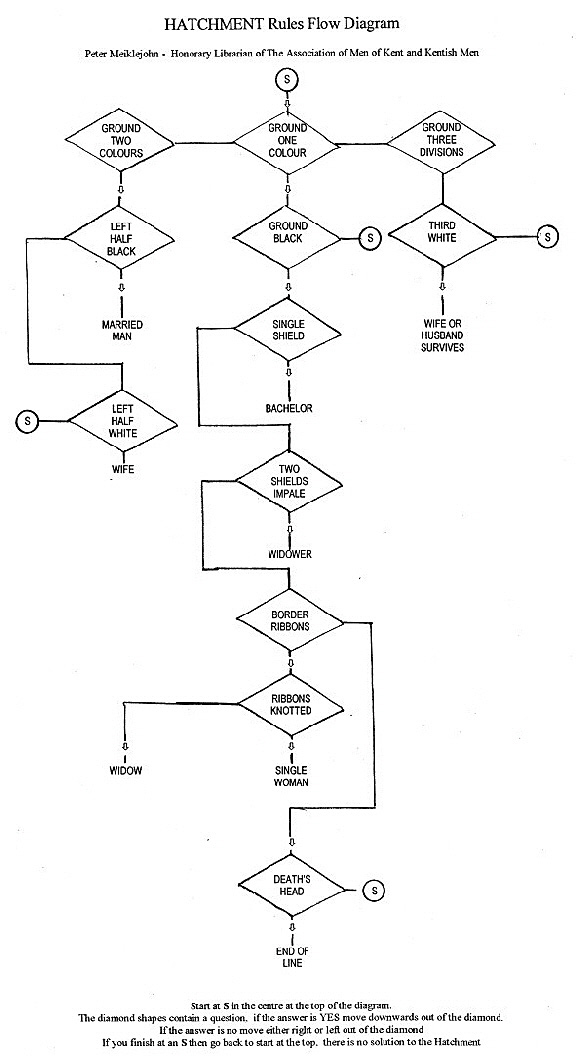Church Hatchments: Illustrated, rules governing them and a Flow diagram
Return to the Lynsted Church Contents Page
| Narrative | Hatchment |
1. Sinister background black Per fess azure and or a pale counterchanged three bucks' heads erased or (Roper), impaling, Azure a chevron engrailed between three lions passant guardant or Baroness's coronet Motto: Spes mea in Deo For Catherine, daughter of Philip, 2nd Viscount Strangford, who m. as his 1st wife, Jan. 1703/4 Henry , 8th Baron Teynham, and d. April 1711. |
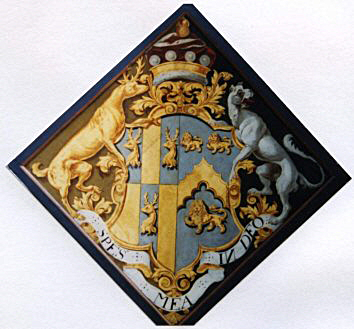 |
2. Sinister background black Roper, impaling, Per saltire vert and argent a saltire gules (Gage) For Mary, dau. of Sir John Gage, 4th Bt., who m. as his 2nd wife, January 1715/16, Henry 8th Baron Teynham, and d.s.p. Jan. 1716/17 |
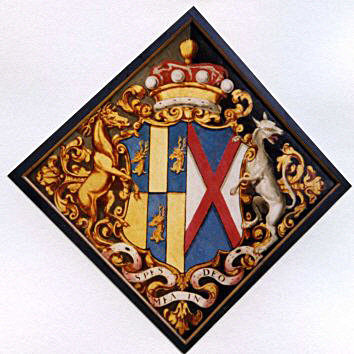 |
3. Dexter background black Roper, impaling, Gules on a chevron or between three roundels argent three roundels sable. Baron's coronet. Crest: A lion rampant sable holding a ducal coronet or. Mantling (slight); Gules and argent Motto: As 1. Supporters : Dexter as 1. Sinister: A Bengal tiger reguardant proper. For Henry, 11th Baron Teynham, who m. 2nd 1760, Elizabeth, widow of John Mills, dau. of Joseph Webber, and d. 10th Dec. 1786. |
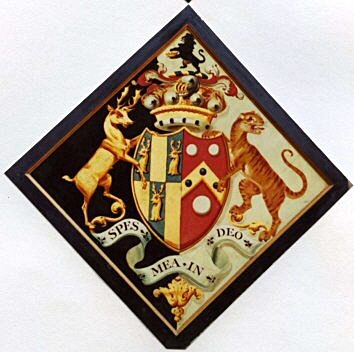 |
4. All black background On a lozenge, surmounted by a baroness's coronet.Arms: As 3. Motto: As 1. Supporters: Dexter : as 1 Sinister, A wolf reguardant proper. For Elizabeth, widow of Henry, 11th Baron Teynham, d. 4th Nov. 1793. |
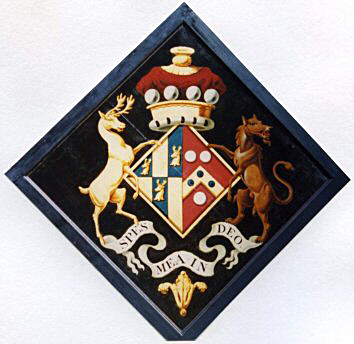 |
5. All black background Roper arms only Baron's coronet. Probably for Philip, 9th Baron Teynham, d unmarried 13th June 1727; Henry, 12th Baron, d. unm. 10th Jan 1800: or John, 13th Baron, d. unm. 6th September 1824. |
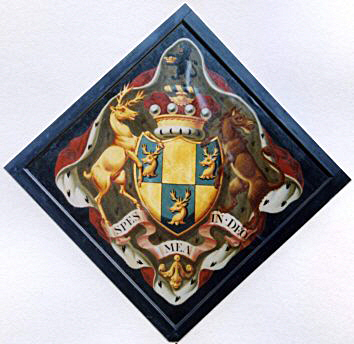 |
6. All black background Roper arms only Baron's coronet. Sinister: A heraldic tyger reguardant argent. Mantling: Gules and ermine. For attribution, see 5 |
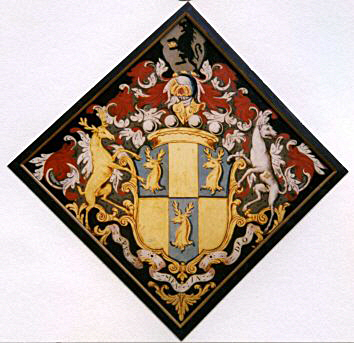 |
7. All black background Roper arms only Baron's coronet. Sinister: A heraldic tyger reguardant argent. All on a mantle gules and ermine For attribution, see 5 |
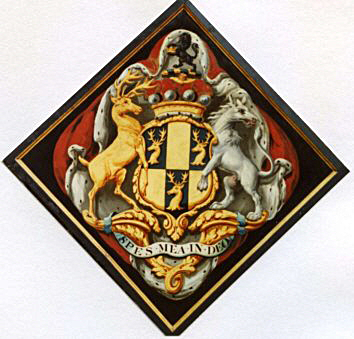 |
8. Sinister background black Argent three lozenge buckles tongues fesswise gules, a molet sable for difference (Jerningham), impaling Roper. Cherub's head above and on each side of shield. For Elizabeth daughter of Christopher, 5th Baron Teynham, who m. Charles Jernngham, and d. |
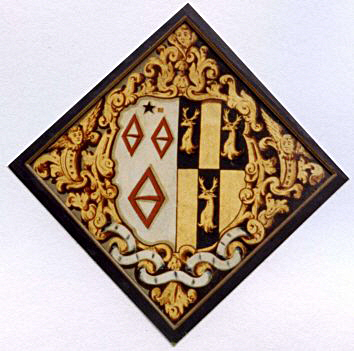 |
9. Sinister background black Sable on a fess or between three cats passant argent striped sable a cross formy between two crescents gules (Tyler), impaling Roper . For Betty Maria, daughter of Henry, 11th Baron Teynham, who married 1785, Francis Henry Tyler, of Lynsted Lodge, and died 1st March 1788 aged 26. |
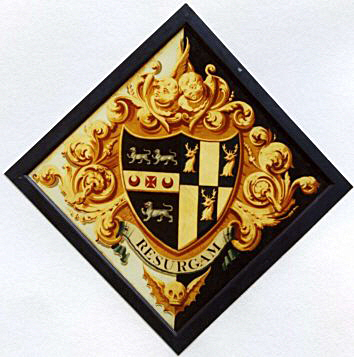 |
17. All black background Sable a fess or between three cinquefoils argent, in a chief a label of three points or for difference (Eve), impaling, Sable a fess dancetty between three cherubs' heads or (Adye) Crest: A horse passant argent Mantling: Gules and argent Frame inscribed: Henry Eve M.D. ob July 1686. Interred the 31st. AEt. 31. also : Dorothy Eve, wife of Henry Eve, M.D. ob. Nov. 1691 Interred Dec 1. |
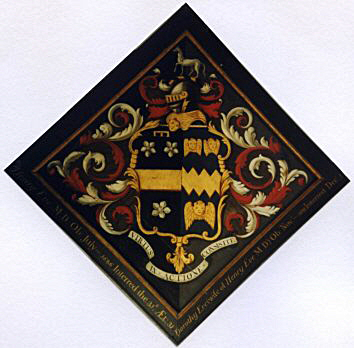 |
18. Sinister background black Sable a fess or between three cinquefoils argent, in a chief a crescent or for difference (Eve). In pretence, and impaling, Eve, without crescent. Crest and mantling: As 17. Frame inscribed: Mrs. Dorothy Eve, the wife of Charles Eve, of Canterbury, Gent, died on June ye 16th 1755. Interred here the 26th instant aged 31 years.. (M.I. confirms above details; she was the daughter and heiress of Henry Eve) |
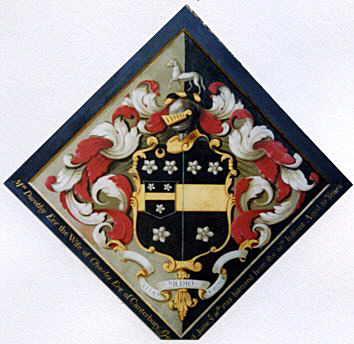 |
Interpretation
Glossary: dexter: right hand side looking from the back of the hatchment; sinister: left hand side.
Azure - blue; argent - silver; gules - red; or - gold; sable - black.
Fess - division of a shield formed by two lines drawn horizontally and occupying one third of it.
Saltire - cross X; Dancetty - zig-zag; impaled - two coat of arms side by side on the same shield; engrailed - scalloped partition line with the spikes outwards; erased - torn from the body, with jagged edges erect upright.
HATCHMENT RULES (also see flow diagram, below)
A hatchment, made of wood and canvas, would be suspended over the front door of a deceased persons house for 6 to 12 months, after which it was moved to inside the parish church. The last recorded use of a hatchment was when one was hung in a London street in 1928. Hatchments were used from the 17th to 19th centuries.
If for a bachelor the hatchment has a black ground.
If for a single woman, her arms are represented upon a lozenge, bordered with knotted ribbons, also on a black ground[1].
If for a married man, his arms upon a shield impale[2] those of his surviving wife; or if she is an heiress they are placed upon escutcheon[3] or pretence, and crest and other appendages are added, the Dexter[4] half of the ground is black, the sinister[5] white.
For a wife whose husband is still alive the same arrangement is used, but only the sinister ground is black
For a widower the same is used as for a married man but the whole ground is black.
For a widow the husband's arms are given with her own, but upon a lozenge[6], with ribbons, without crest or appendages, and the whole ground is black.
When there have been two wives or two husbands the ground is divided into three parts per pale, and the division behind the arms of the survivor is white.
In the rare event of the 'End of the line' a 'Death's Head' is displayed. (A Death's Head is a human skull or representation of it)
When the deceased is a military or naval officer, colours and military or naval emblems are sometimes placed behind the arms.
Thus it is easy to discern the sex, condition, quality and particularly the social standing, and possibly the name of the deceased.
In Scottish hatchments it is not unusual to include the arms of the father and mother, and grandparents, of the deceased in the two lateral angles of the lozenge.
Restricted mainly to the British Isles and the Netherlands.
- Ground: surrounding area or background
- Impale: To display arms either side of a vertical line on a shield
- Escutcheon: A shield or shield shaped emblem bearing a coat of arms
- Dexter: The wearers right, the observers left
- Sinister: The wearers left, the observers right
- Lozenge: Four sided figure with a diamond shape.
[Peter Meiklejohn - Honorary Librarian of The Association of Men of Kent and Kentish Men]
